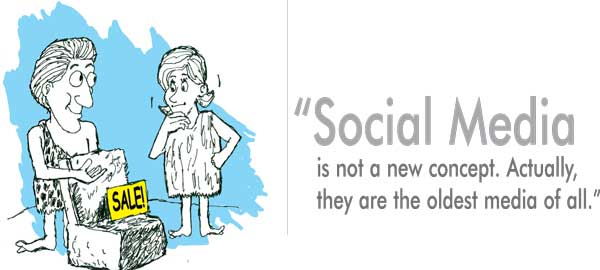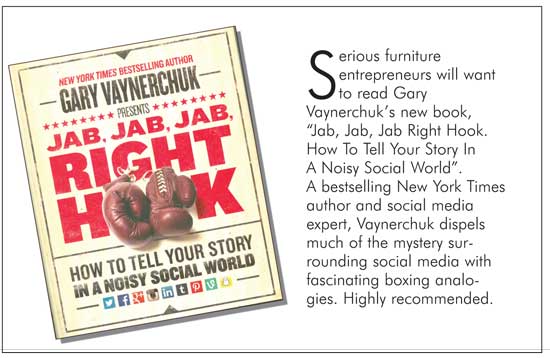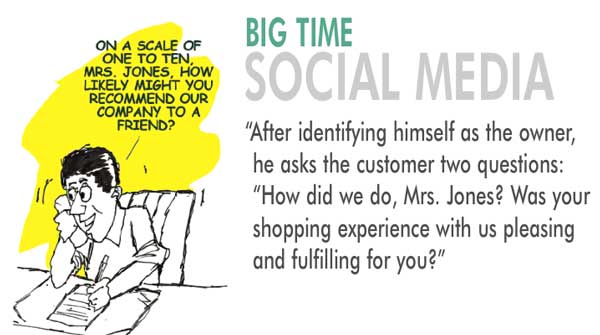If someone had said, not many years ago, that “What the retail home furnishings industry needs is a medium that would be focused on authentic prospects, be non-intrusive and welcome, be easy to use and would be virtually free,” we would likely have thought that person to be nuts. Yet the Internet and social media are here. And the home furnishings industry is almost totally unprepared for it.
Furniture World has featured several excellent articles on using the Internet and the emergence of social media. However, many furniture entrepreneurs tell me they are confused about practical applications of social media. This is unfortunate, because the wise independent can now make important inroads in market share by integrating social media and the Internet with other media. The possibilities are staggering, especially for the independent who wants massive marketing leverage that the big box stores cannot match.
But first, what are the facts and fallacies regarding social media that independent furniture entrepreneurs need to know?

SOCIAL MEDIA facts
- Social media are the fastest growing media ever.
- Social media are not just impacting traditional marketing, they are also undermining digital media as well. [Email, internet banner ads, Google AdWords.]
- When you add a social component to any media platform, you automatically increase its effectiveness.
- The power of social media, just as any media, revolves around a compelling story, appropriate to the media platform. In other words, the principles of good brand advertising still apply.
- Big ticket marketing, such as advertising for home furnishings stores, requires a very different approach to social media than small tickets.
SOCIAL MEDIA FALLACIES
- Social media is a new concept. Actually, they are the oldest media of all.
- Social media are stand-alone platforms that will eventually make radio, TV, direct mail and print obsolete. Actually, they will not replace traditional media.
- To be effective with social media you need to hire a social media expert and have a presence on all the platforms. Actually, an intelligent home furnishings entrepreneur can effectively target a few social media and do very well by investing a reasonable amount of money, time and energy.
The fact is that not all social media are effective for attracting big ticket home furnishings prospects. Your take away from this series will hopefully be a crystal clear idea of how to employ the right social media to complement and turbo-charge your other media.
First of all, let’s blow away the fallacy that social media is new. Rather, it is the oldest media of all!
Social Media Was First
Few sales of significant size and importance are made without memorable, game-changing conversations. True, there are prospects with cell phones who buy furniture from the Internet. But often they first shopped, and were sold a specific product by a hapless brick and mortar sales person. Then they left the store without buying in order to order it at a lower price from the Internet. The power of the one-on-one conversation remains the most effective method of selling on earth. Especially for big tickets. I originally called social media “People Media.” [See www.furninfo.com, search: “Larry Mullins People Media” and you will see articles dating back to 2008]. What has changed since then are the ways People Media are delivered. But, regardless of this, one-on-one real life People Media will most often make or break your brand.

To the CEO of a modern retail furniture company, there are three key ways People Media impact your business: Your leadership ability can be evaluated by the quality of the messages you communicate to your executives, managers and associates. (These messages include body language and actions as well as words.) The resulting morale of your company can be determined by the quality of the messages that the members of your staff communicate to each other. And the status of your brand will be determined by the total shopping experience of your customers. Much of this shopping experience will be created by the quality of the messages (both verbally and by their performance) that your associates communicate to your customers. Ultimately, most important of all are the messages your customers communicate to their friends and neighbors. And now, with the emergence of social media, your customers have a bully pulpit to communicate their shopping experience to virtually the entire world.
Social Media and Traditional Media
The radio revolution impacted print media, but it did not replace it. Likewise, as powerful as TV hit radio, it did not replace it. Social media expert Gary Vaynerchuk points out: “… Internet and digital media options (are) pulling the audience away from television and print. Still, when properly aligned, these three platforms could complement each other effectively.” Bingo. To repeat what I wrote earlier, your take away from this article will hopefully be a crystal clear idea of how to employ the right social media to complement and turbo-charge your other media. Where do you start? With your story: your USP (Unique Selling Proposition).
People don’t like to be sold, but they love good stories. The reason people are not paying as much attention to furniture advertising anymore is that most of it sounds and looks alike. Big boxes flood the newspapers with big, colorful flyers, and to the independent they seem invincible. However, if you examine the content of the big box material, it is all label headlines, item-price and credit offers, just as marketing was done in the eighties. All the big boxes claim lower prices and extended credit offers. No stories, no benefits, no unique why to buy. No wonder people are less interested. Make no mistake, the power of social media, just as any media, revolves around a compelling story, appropriate to the media platform. In other words, the principles of good advertising and branding still apply for social media.
Unfortunately, the smaller independents generally attempt to copy the big boxes. They rely on look- and sound-alike price-item offers and label headlines. Yet, the myth of big box indomitability penetrates the mind of smaller independents, putting them at an immense psychological disadvantage. Even though independents have a substantial advantage in leverage points, they remain unused and the battle for market share is lost before it really begins. Nowhere is this failure more obvious than in the way the independent furniture store fails to use social media in ways the big box simply cannot. Let us count the ways.
WEBSITES. Local smaller merchants can enhance their websites with social media in effective ways that are not now possible for a big box franchise. A website without a link to Facebook is like a romantic night without stars. An effective presence on Facebook takes some time and patience, but it is an immensely important medium. You can really tell your story on Facebook. You do not need to be a computer whiz to set up an account and do it. A low cost, valuable program for doing this can be found at
www.fbinfluence.com.
Videos will lift your website from boring and remote to real, personal and warm. Instead of a tab that reads: “About Us” with a page jammed with copy that no one reads, the prospect who clicks that tab could watch a two minute or so video of you being your beautiful hometown self. With today’s computer cameras and a little practice you can crank out excellent videos for mattresses, community involvement, selection, and so on. Check www.slumberlandwillmar.com to see how this is done. This store is located in a relatively small rural area of Minnesota. Note how the story of this great store is told in a fun, compelling way. Keep in mind these videos were done locally, not by the corporation. Videos improve your website’s Google rating. Also, be sure to keep your content current by posting your ads on your website. Always remove them when they are no longer current. Glitz does not make a website work. Content does.
One would imagine that, given the power of colorful, fascinating, personalized local website platforms, big box corporations would be scrambling to create them for their franchises. (Rather than relying solely on a central website with sterile, inadequate local franchise addresses and maps.) Not so. Both their IT and legal departments are overloaded, and their alleged lack of time and their real lack of will persuades the CEO to avoid investing in local social media. Gary Vaynerchuk describes this situation as a “shocking lack of effort for showing care and respect” for social media communities that form around their businesses. All of these issues are massively advantageous for smaller independent retailers, who (for a change) can be on offense rather than defense.
 GOOGLE AdWords.
GOOGLE AdWords. If you Google “furniture” “mattresses” or “home furnishings” and your city name you will see a list of stores. On the right, alongside the search results, you will see advertisements related to your search query. (Mostly by big box stores, few independents have discovered AdWords.) Since the ads are relevant to your query, they often serve you better than the actual search results. The search results will only point the prospect to stores that are selling the specific product, such as mattresses. However, the ads can compel the prospect to take immediate action to take advantage of a specific offer: “Click here, we offer a 120-day comfort guarantee for your mattress, or we will take it back.”
For the advertiser the benefit is two-fold. First, only if a user clicks on the ad (i.e., enters the website or online-shop) is the advertiser charged for the advertisement. Second, the ad is only shown if the user is actively looking for what the advertiser has to offer. The advertiser is provided instant feedback to determine if an ad is working or not. The value of this kind of non-intrusive permission advertising is immense, a huge breakthrough. The cost is miniscule compared to TV advertising, which is a cluttered and intrusive medium in which the prospects can be forced to watch ad after ad parade by in a linear manner, featuring products which they have no interest in acquiring. No wonder technology is making it easier to avoid the intrusion of TV commercials!
Internet ads can be updated at a moment’s notice—no more waiting for an agency to remake a weak commercial or the printer to create new flyers. With micrometer-like precision, statistics are available on how often ads were seen, clicked on and what keywords were searched for. Advertisers can continue to track the users on their website while they shop, optimize the presentation for the shopping experience and much more.
There’s an interesting twist on how advertisers are billed: the ad positions are auctioned off. To learn more about how this works, Google “AdWords” or “AdWords Express.”
No Time For Social Media?
There is a great leather furniture entrepreneur in Florida by the name of Jeff Cohen. For six years or so Jeff has struggled with a small showroom, a low budget, and a difficult location. (Not to mention that he took over his store just as the economy tanked.) But Jeff has two secrets. First, he is obsessed with personal service, achieving several five star reviews on Google. Second, Jeff has mastered several aspects of social media. As a result Jeff is regularly awarded “Best Furniture Store” in St. Augustine. He has added several premier leather brands, including the Ekornes’ Stressless line and Natuzzi. His website is rich with content, including testimonials and videos. (
www.leatherbydesign.com) He uses AdWords. He has a strong presence on Facebook. Jeff has captured snail mail addresses and built a mailing list. And he has built an email list and uses it effectively. He hands every guest a small trifold flyer before they leave the store. Jeff treats his associates, customers and vendors with courtesy and respect. Because Jeff is the real deal, his People Media are awesome.
Like most of the rest of us, Jeff is no computer mega-whiz. What he knows he has learned by patience and hard work. He is wise enough to farm out the highly technical digital stuff. But the hard work of People Media is maintaining authenticity and integrity. Jeff told me that when a customer has a problem it translates for him as an opportunity to provide superlative customer service.
Brick and mortar retail is one of the toughest careers an individual can choose, especially for the sincere home furnishings entrepreneur. A few words, body language gestures, or facial expressions communicate volumes to associates and customers. The essence, and core of social media begins with the entrepreneur.
Another hard working furniture entrepreneur I know takes time to call every larger ticket sale. After identifying himself as the owner, he asks the customer two questions: “How did we do, Mrs. Jones? Was your shopping experience with us pleasing and fulfilling for you?” And, “On a scale of one to ten, Mrs. Jones, how likely would you be to recommend us to a friend?” This guy knows that his sales consultants and personnel are not just his store but him as far as the customer is concerned. He trains his staff accordingly. He knows that the delivery personnel are likely the last contact with the customer his store will have. They are trained to reinforce the customer’s buying decision. After placing the purchase in the home, the delivery captain will say something like: “That is a gorgeous recliner you selected. La-Z-Boy is a wonderful brand.” Or possibly: “The mattress you selected is one of Sealy’s best-selling. People love it because it combines memory foam technology with proven innerspring design.” This greatly dispels chances of buyer’s remorse.
What About The Other Social Media?
There remain four more major social media players: Twitter, Pinterest, Instagram and Tumblr. There also is much more to say about telling your story on Facebook, and how even dummies like me can use Google Analytics and enjoy competitive advantage. I will cover these issues in Part Two of this series. One purpose in this article was to dispel some of the misconceptions about social media. In this series I also hope to inspire you to add 20% or so to your bottom line in 2014 by exploring some simple and easy to use social media techniques. As I stated at the start of this article, the possibilities are staggering, principally for the independent who wants massive marketing leverage that the big box stores cannot match. Whether you choose to or not, you are using People Media every moment of every day. Social media adds new tools that others have learned to use knowingly, creatively and effectively to their advantage. You can too.
Larry Mullins is a contributing editor for Furniture World and has 30+ years of experience on the front lines of furniture marketing. Larry’s mainstream executive experience, his creative work with promotion specialists, and mastery of advertising principles have established him as one of the foremost experts in furniture marketing. His affordable High-Impact programs produce legendary results for everything from cash raising events to profitable exit strategies. His newest books, THE METAVALUES BREAKTHROUGH and IMMATURE PEOPLE WITH POWER… How to Handle Them have recently been released by Morgan James Publishing. Joe Girard, “The World’s Greatest Salesman” said of this book: “If I had read Larry Mullins’ book when I started out, I would have reached the top much sooner than I did.” Larry is founder and CEO of UltraSales, Inc. and can be reached directly at 904.794.9212 or at Larrym@furninfo.com. See more articles by Larry at www.furninfo.com or www.ultrasales.com.